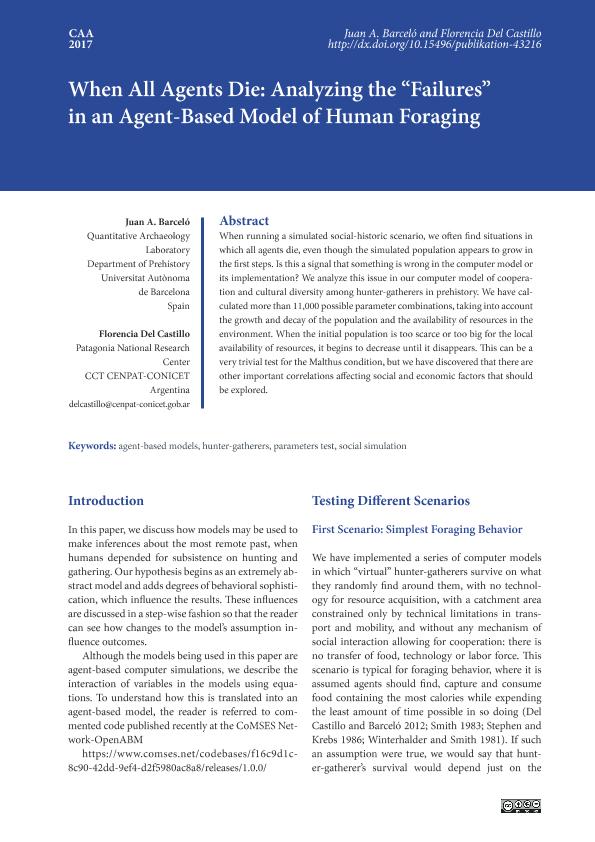Mostrar el registro sencillo del ítem
dc.contributor.author
Barceló, Juan A.
dc.contributor.author
del Castillo Bernal, María Florencia

dc.date.available
2022-01-20T13:57:25Z
dc.date.issued
2020
dc.identifier.citation
When all agents die: Analyzing the "failures" in an agent-based model of human foraging; 45th Annual Conference of Computer Applications and Quantitative Methods in Archaeology; Atlanta; Estados Unidos; 2017; 205-219
dc.identifier.uri
http://hdl.handle.net/11336/150424
dc.description.abstract
When running a simulated social-historic scenario, we often find situations in which all agents die, even though the simulated population appears to grow in the first steps. Is this a signal that something is wrong in the computer model or its implementation? We analyze this issue in our computer model of cooperation and cultural diversity among hunter-gatherers in prehistory. We have calculated more than 11,000 possible parameter combinations, taking into account the growth and decay of the population and the availability of resources in the environment. When the initial population is too scarce or too big for the local availability of resources, it begins to decrease until it disappears. This can be a very trivial test for the Malthus condition, but we have discovered that there are other important correlations affecting social and economic factors that should be explored.
dc.format
application/pdf
dc.language.iso
eng
dc.publisher
Tübingen University Press
dc.rights
info:eu-repo/semantics/openAccess
dc.rights.uri
https://creativecommons.org/licenses/by-nc-nd/2.5/ar/
dc.subject
parameters test
dc.subject
AGENT BASED MODELS
dc.subject
HUNTER GATHERERS
dc.subject
SOCIAL SIMULATION
dc.subject
PARAMETERS TEST
dc.subject.classification
Arqueología

dc.subject.classification
Historia y Arqueología

dc.subject.classification
HUMANIDADES

dc.title
When all agents die: Analyzing the "failures" in an agent-based model of human foraging
dc.type
info:eu-repo/semantics/publishedVersion
dc.type
info:eu-repo/semantics/conferenceObject
dc.type
info:ar-repo/semantics/documento de conferencia
dc.date.updated
2022-01-05T18:27:03Z
dc.journal.pagination
205-219
dc.journal.pais
Estados Unidos

dc.journal.ciudad
Atlanta
dc.description.fil
Fil: Barceló, Juan A.. Universitat Autònoma de Barcelona; España
dc.description.fil
Fil: del Castillo Bernal, María Florencia. Consejo Nacional de Investigaciones Científicas y Técnicas. Centro Científico Tecnológico Conicet - Centro Nacional Patagónico. Instituto Patagónico de Ciencias Sociales y Humanas; Argentina
dc.relation.alternativeid
info:eu-repo/semantics/altIdentifier/doi/http://dx.doi.org/10.15496/publikation-43216
dc.relation.alternativeid
info:eu-repo/semantics/altIdentifier/url/https://publikationen.uni-tuebingen.de/xmlui/handle/10900/101837
dc.conicet.rol
Autor

dc.conicet.rol
Autor

dc.coverage
Internacional
dc.type.subtype
Conferencia
dc.description.nombreEvento
45th Annual Conference of Computer Applications and Quantitative Methods in Archaeology
dc.date.evento
2017-03-14
dc.description.ciudadEvento
Atlanta
dc.description.paisEvento
Estados Unidos

dc.type.publicacion
Book
dc.description.institucionOrganizadora
Tübingen University Press
dc.source.libro
Digital Archaeologies, Material Worlds
dc.date.eventoHasta
2017-03-16
dc.type
Conferencia
Archivos asociados
